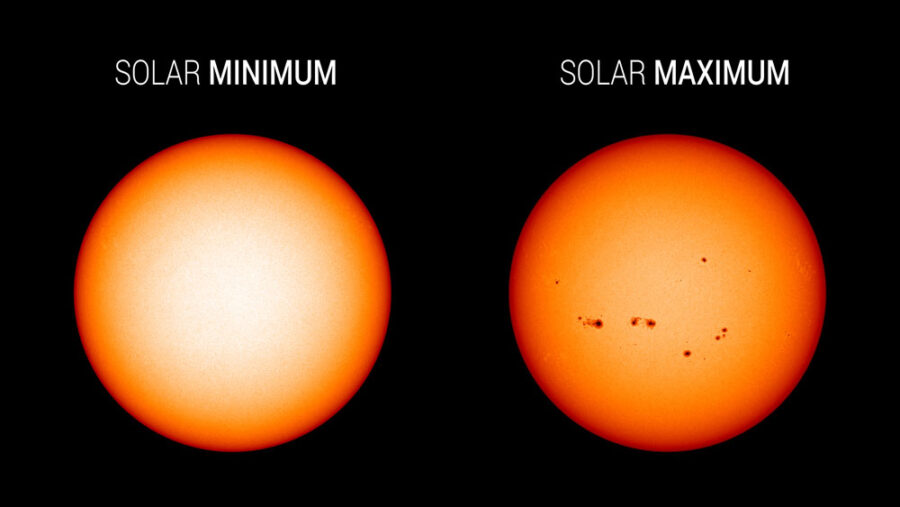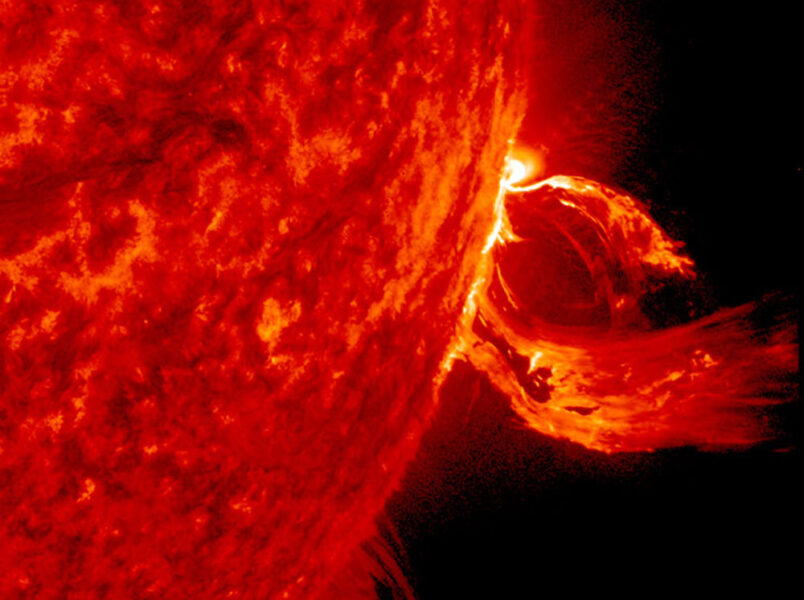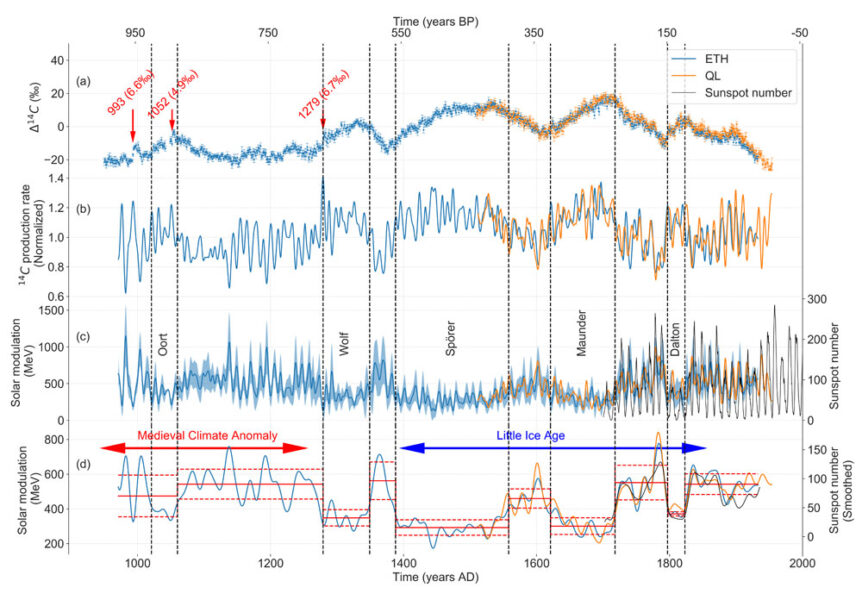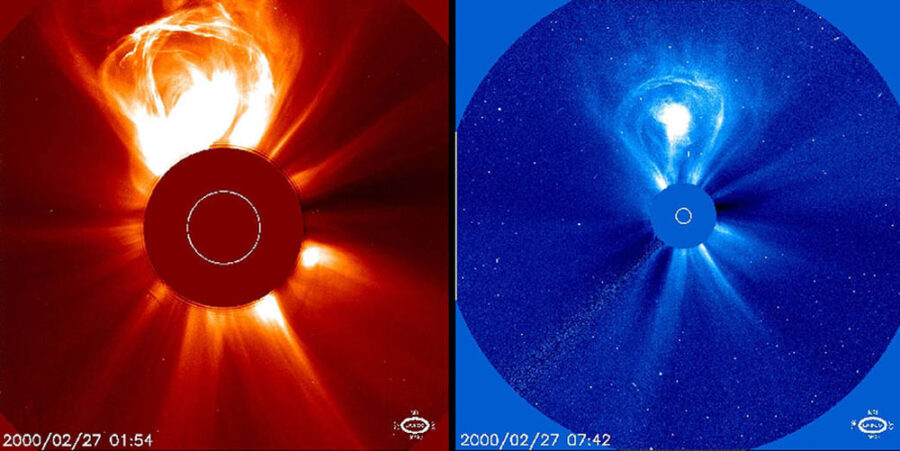Astronomers are using tree rings as a historical record of solar activity — and they’ve found that the Sun was much more active in the past.
Our Sun is not the faithfully constant light source it appears to be. Solar activity varies in a fairly regular cycle of 11 years, most notably in the periodic rise and fall in the number of sunspots. Though German astronomer Samuel Heinrich Schwabe discovered the cycle in the 19th century, sunspot observations commenced about 400 years ago with Galileo Galilei, and the solar cycle has been traced back to these early observations.
Now, a team of scientists based in Switzerland has successfully reconstructed the 11-year Schwabe cycle all the way back to the year AD 969, using the Sun’s imprint on ancient trees on Earth. Their report appears in Nature Geoscience.

NASA
Tree Rings and Solar Activity
Tree rings provide a record of Earth’s environmental past. Trees grow new rings every year, their thickness depending on the abundance of water and general climatic conditions. By carefully assigning rings to specific years, scientists can study how Earth’s climate evolved over time.
Nicolas Brehm (ETH Zürich, Switzerland) and colleagues used samples of cut-down trees, some found as construction material in historic buildings in England and Switzerland, to reconstruct the Sun’s varying impact on our planet by measuring their content of radioactive carbon-14.
Carbon-14, or radiocarbon, has eight neutrons in addition to its six protons and is a rare variant of the more typical carbon atom that has only six neutrons. Due to the extra neutrons, the rarer nucleus decays into nitrogen with a half-life of 5,730 years.
Radiocarbon is present on Earth because energetic particles from the Sun are constantly hitting nitrogen atoms in the upper atmosphere, converting them into radiocarbon. The freshly produced carbon-14 atoms are incorporated into carbon dioxide molecules and ultimately absorbed by living plants or animals. As long a creature is alive, its ratio of radio to regular carbon remains constant, at about one part per billion. After death, the amount radiocarbon begins to decrease, so scientists can measure its abundance to date historic organic material.

SDO / NASA
Brehm and colleagues turned this method on its head: First, they dated each sample, ring by ring, using available historic tree-ring records. Then, knowing the exact age of each tree ring in their samples, they tried to figure out how much carbon-14 there was in the atmosphere as each tree ring grew, and how this abundance changed from one year to the next.
The tree rings should contain different amounts of carbon-14, depending on the Sun’s activity: In times of high activity, the solar magnetic field and the solar wind are stronger, effectively shielding Earth from radiocarbon-forming galactic cosmic rays. When solar activity is low, so is its protective shield, and more cosmic particles can reach Earth. Higher solar activity (as measured by sunspots) should thus generally yield lower carbon-14 abundances, and vice versa.
However, the Sun’s impact on carbon-14 production is very small, and weather-induced noise is of the same order of magnitude as the expected signal. Earlier attempts by other groups therefore yielded inconclusive results. Moreover, the very low concentration of carbon-14 requires large samples of tree cores, and its abundance takes a long time to measure. To cover a millennium-long timespan (from AD 969 to 1933) would be too time-consuming if done in the traditional way.
So the team took a novel approach: Instead of measuring radioactivity emitted by the decaying carbon-14, as has been done for previous tree-ring studies of solar activity, they counted the atoms directly with an accelerator mass-spectrometer (AMS). That is, they vaporized the samples to ionize their atoms, then used a magnetic field to accelerate the ions and separate them by mass. Developments in AMS technology at ETH Zürich meant that the scientists could use much smaller samples (from millimeter-thick drill holes), speed up the measurement process, and reach the precision required.
The result, published in Nature Geoscience, more than doubles the previous annually resolved carbon-14 record. By successfully matching the carbon-14 production rates with solar activity over the past 400 years, the scientists could extend solar activity records into times well before the invention of the telescope.

Brehm et al. / Nature Geoscience 2021
A Millennium of Solar Activity
During times of prolonged decreases in solar activity, carbon-14 production rates went up as expected: The periods when sunspots were scarce, especially during the Spörer, Maunder, and Dalton minima, are clearly visible in the tree-ring record.
The scientists also identified three sharp peaks of increased radiocarbon production, which they associate with exceptional solar eruption events in the years 993, 1052, and 1279. The first was originally discovered and published in 2013, from an independent tree-ring analysis. Now, with the events detected in this study, Brehm says it seems statistically improbable that anything other than the Sun could have caused them.
However, all three events seem to have originated from solar eruptions much more intense, or at least different from major solar eruptions observed in modern times — including the infamous Carrington event in 1859. In fact, the 1859 eruption left no trace in the carbon-14 records.

SOHO ESA & NASA
It’s almost as if our Sun has a double personality: Most of the time it’s a kind of protective “older brother” that shields us from energetic particles zooming around the galaxy, but sometimes it turns into a violent bully, hitting us with its own punch of particles when we least expect it.
This work helps expand our star’s activity record over much longer timespans than were previously accessible. It also yields a better assessment about the probability of potentially dangerous solar eruptions, the authors write. Team member Lukas Wacker (ETH Zürich, Switzerland) says the team is already working on extending their analysis. Precisely dated tree-ring data are available for the last 12,000 years, and according to Wacker, there might already be evidence supporting other historic solar eruptions.
Reference:
Brehm, N., Bayliss, A., Christl, M. et al. Eleven-year solar cycles over the last millennium revealed by radiocarbon in tree rings. Nat. Geosci. 14, 10–15 (2021). https://doi.org/10.1038/s41561-020-00674-0
Editorial notes (February 9, 2021): An earlier error was corrected regarding the number of neutrons in carbon-14. The text has also been corrected to note three events, not four, were discovered in this analysis.
 7
7









Comments
mhawkins.consultant
February 8, 2021 at 1:17 pm
It used to be called "The Medievil Warm Period" until the climate alarmists deemed that too embarrassing to their cause. So now it's dumbed down to "Medievil Climate Anomaly" and the whole warm epoch is now just hiding in plain sight.
You must be logged in to post a comment.
[email protected]
February 9, 2021 at 9:46 am
Thank you mhawkins,
At least the "Little Ice Age" hasn't been renamed to "Brief absence of Abnormal Warming". Recent introduction of new words, names and phrases almost qualifies as Newspeak.
You must be logged in to post a comment.
Monica Young
February 11, 2021 at 10:54 am
The term changed when scientists began to realize the "medieval warm period" was not a global phenomenon. Terms change to reflect changing understanding.
You must be logged in to post a comment.
mhawkins.consultant
February 17, 2021 at 3:43 pm
there is no consensus that the temperature anomaly was northern hemispheric. Many scientists still subscribe to the anomaly as global. Soon and Baliunas (2003) found that 92% of 112 studies showed physical evidence of the MWP, only 2 showed no evidence, and 21 of 22 studies in the Southern Hemisphere showed evidence of Medieval warming.
You must be logged in to post a comment.
Monica Young
February 19, 2021 at 11:02 am
The Soon and Baliunas 2003 paper was highly controversial, and climate scientists whose work was misrepresented in that paper published a response, available here: https://web.archive.org/web/20100117140755/http://www.agu.org/news/press/pr_archives/2003/prrl0319.html. The Britannica Encyclopedia has a nice summary of the Medieval Warming Period: https://www.britannica.com/science/medieval-warm-period that should be useful for the general reader.
You must be logged in to post a comment.
KHartnett
February 12, 2021 at 7:05 pm
Please explain or elaborate on the last sentence, as the oldest known trees, I believe, are only about 5,000 years old. Thanks. Interesting article.
You must be logged in to post a comment.
Dan Pernokis
February 12, 2021 at 10:01 pm
Humans live only 70-80 years but have a history going back thousands of years -- because generations overlap.
Dendrochronologists (tree-ring scientists) take overlapping matching ring patterns from generations of trees to span back much farther than the age of any single tree. Match the ring pattern for a pair of 5000-year-old trees for as little as fifty overlapping years and you're already almost 10,000 years into the past. Of course it takes a lot more trees and statistics to do the job properly, but that's the gist of it.
You must be logged in to post a comment.
You must be logged in to post a comment.